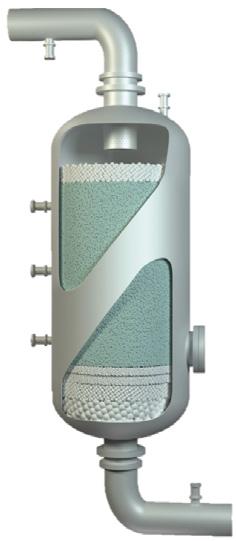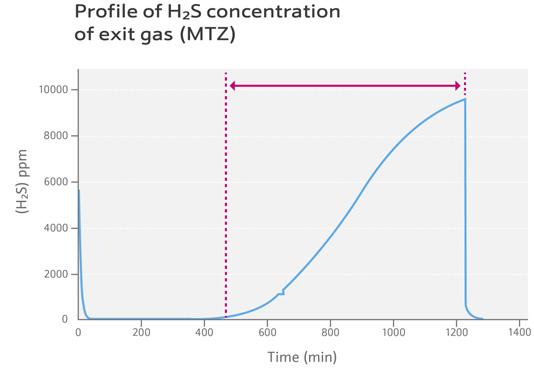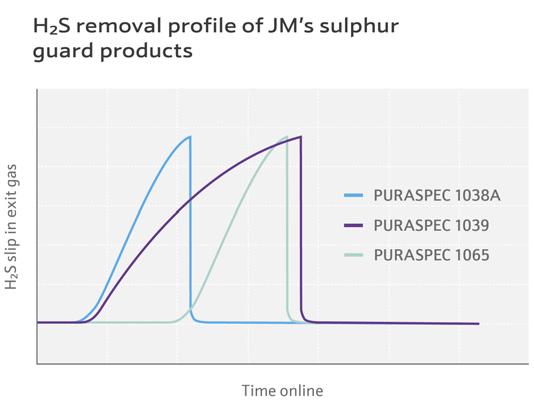
11 minute read
So long sulfur












Kevin Young, Johnson Matthey, USA, explains the technology behind a new high capacity sulfur absorbent which aims to advance performance and reduce process costs.

Sulfur in the form of hydrogen sulfide (H2S) is a very toxic and corrosive compound which needs to be removed from natural gas before it is converted into LNG – the form where it can be used by businesses and homes. As the world is transitioning to more low carbon sources, LNG is taking a central role in this process which is reflected in the ongoing growth in demand.
Some sources of natural gas contain significant amounts of sulfur. Upon the combustion of sulfur containing gas, sulfur dioxide (SOx) can be formed which may lead to potential health issues such as respiratory and cardiovascular disease.
In addition, environmental issues arising from SOx emissions include the formation of acid rain that adversely affects ecosystems, as well as technical issues such as pipework corrosion or downstream catalyst poisoning, costing the industry billions of dollars per year as a result of catalyst replacement and process shutdowns.
If sulfur impurities in gas are not effectively reduced to a very low concentration before use in other chemical processes, it irreversibly poisons the metal catalysts, reducing their activity, selectivity, and lifetime – being especially detrimental to those used for both catalytic reforming and fuel cells electrodes.


A variety of processes exist for the removal of H2S from gas streams, dictated by the concentrations of sulfur that need to be removed, and the volumes of gas that need to be processed.
Johnson Matthey’s PURASPEC™ absorbents are well suited to polishing duties requiring removal of relatively low levels of H2S. The company’s fixed bed technology has been designed to offer a simple solution and a low capital cost for sulfur removal (Figure 1).
The sulfur capacities of a PURASPEC absorbent are not sensitive to temperature or pressure within the typical gas processing operating conditions envelope, and are highly selective towards H2S removal from natural gas, CO2, and liquid hydrocarbon streams, with a robust performance within a wide compositional range and different flow-sheet locations.
PURASPEC absorbent performance is also not affected by the water content of the stream, provided it is run in a single phase and the material does not require water saturated streams to achieve expected sulfur capacities.

Figure 1. Typical layout of a PURASPEC absorbent bed.
Figure 2. Schematic showing gradual saturation of the bed of absorbent material with H2S.

Benefits of granulated products
To convert active raw material powders into a more useful form they are formed into granules (Figure 6). This requires the addition of binders to the active copper powders, to ensure the product acquires the desired characteristics, such as strength, porosity, density, and activity.
Due to the inherent porosity combined with possible achievable strength of granules, granulation was chosen by Johnson Matthey (JM) as the preferred and optimum forming technique for all purification products, and the company has decades of experience in this area.
With controlled addition of the active copper powders in the granulation process, the product has an exceptionally high capacity for sulfur in addition to a fast rate of reaction to pick up sulfur at low temperatures.
In addition, the high strength and low attrition of the granulated product has benefits for the customer, including reduced risk of pressure drop as well as easy charging and discharging of the product.
When assessing the effectiveness of a sulfur guard, the key specifications for performance are: Total sulfur capacity – strongly linked to the active metal concentration.
Kinetic activity.
The kinetic activity of the product will be influenced by factors such as particle size and porosity of the product, and this has an effect on the mass transfer zone (MTZ).
The MTZ is the volume of material required to reduce the inlet H2S content to undetectable levels, and is the difference between the initial sulfur breakthrough and the total saturation capacity of the bed indicating the efficiency of the rate of reaction and sulfur removal, so the lower this value and the closer together these two points are, the better.
To demonstrate this, Figures 2 and 3 show a fixed bed of product and its pick-up of sulfur over time. As gas containing H2S passes over the bed, a profile of how much of the bed is saturated is generated, with the darker grey colour indicating the copper sulfide forming from this reaction. For a period of time, no H2S is seen in the exit of the bed but as the product begins to saturate, H2S slip is observed until eventually inlet H2S concentration becomes the same as the exit concentration, i.e. the bed is saturated.
For an ideal absorbent the preferable result is a long initial breakthrough time as well as short MTZ, which suggests the product is being utilised efficiently as this will translate into longer bed lives and reduced change-out of the vessel with fresh material.
How the sulfur absorbents work
H2S reacts with the copper active sites on the surface of the granule forming copper sulfide. This causes a shrinkage of the primary crystallites, which generates porosity in the granules and, therefore, allows for easier access for the H2S to react further with the active copper in the bulk of the granule – i.e. no mass transfer diffusion limitation, which is

Figure 3. The bed exit H2S profile generated during processing of gas containing H2S. Note the MTZ is elongated on the graph as the test is an accelerated laboratory test using % levels of H2S in the feed gas.
Figure 4. Graph illustrating the improvement in performance of JM’s sulfur guard absorbent products.
Figure 5. Graph showing the comparative performance between JM’s sulfur guard absorbent products. especially important at low temperature operation. This process continues until the material is fully converted to copper sulfide and spent. This is associated with a change in colour from green to black.


The evolution of the technology
JM has references in gas purification dating back to 1984 and has supplied products for both onshore and offshore applications in the gas processing industry.
The initial purification product developed by JM was based on developments of the high temperature zinc oxide absorbents used in syngas markets. Such developments showed great improvements in low temperature performance over those original formulations but were still lower than ideal for the application. The first-generation copper-based mixed metal product, PURASPEC 1030, was developed in the 1980s and was successfully installed in numerous plants as a replacement for the previous zinc-based technology, showing vastly improved performance at low temperatures.
During the 1990s, PURASPEC 1038 was developed as the next generation sulfur guard with an improved combination of composition and physical properties which improved sulfur pick-up performance by 50%.
JM developed PURASPEC 1039 in the 2000s and it has a higher copper content than PURASPEC 1038, meaning it is able to remove higher amounts of sulfur per unit volume of absorbent. In addition, the use of enhanced manufacturing techniques allowed an increase in the density of the material while retaining good kinetic performance. This improved manufacturing capability also led the company to develop PURASPEC 1038A, JM’s current standard product.
Since the launch of PURASPEC 1039, JM has continued to innovate in the area of sulfur removal, and now through a combination of improved manufacturing processes and control of the granule structure this has resulted in the launch of PURASPEC 1065, the highest sulfur capacity of any of the company’s products to date (Figure 4).
The latest product
PURASPEC 1065 has been developed as JM’s new high capacity, high activity product. It is an extension of the company’s current offering and encompasses: An increase in the amount of active phase in the product. An increase in the product density.
The product also has a smaller particle size compared to the previous generation products to increase the geometric surface area in the bed and reduce potential diffusion limitations. As it has a relatively high density, this smaller size granule gives the product fast removal kinetics and low MTZ, ensuring a high sulfur pick-up per volume of the absorbent.
The reduction in particle size could cause an increase in differential pressure (DP) in the purification vessel. However, the superior sulfur capacity allows the loading of smaller quantities of PURASPEC 1065 (in existing applications) to negate a


Figure 6. JM sulfur guard granules.
possible DP increase. For new applications, the company’s Technical Services team is able to advise on the appropriate vessel diameter to minimise the DP within duty requirements.
This combination of changes provides a product which has a 25% improvement in H2S pick-up over its predecessor. This directly translates into a 25% reduction in the required bed volume of material (lower cost per kg of sulfur removed) or 25% increase in bed life for equivalent bed volume (less frequent vessel change-outs).
Performance evaluations on JM’s bespoke test rig have clearly shown the benefit of PURASPEC 1065 in terms of total sulfur capacity and impressive kinetics. The initial H2S breakthrough at the exit of the bed for PURASPEC 1065 occurs at a much later time, alongside a sharp H2S exit profile and short MTZ.
Comparative performance of PURASPEC 1065 vs PURASPEC 1039 and PURASPEC 1038A in JM’s accelerated laboratory testing can be seen in Figure 5. The H2S removal profiles show that despite having the highest density, PURASPEC 1065 has the lowest MTZ – which is slightly better than PURASPEC 1038A and approximately 15 - 20% lower than PURASPEC 1039.
The improvement in performance and reduction in OPEX/CAPEX also offers positive environmental, health, and safety benefits. The use of smaller vessels to give the same bed life compared to the predecessor materials or a reduced change-out frequency of existing vessels yields a reduced carbon footprint from transportation of products. Less frequent change-out means fewer inherently hazardous operations being required to maintain continuous sulfur removal from a process.
JM has developed this product over the past few years through rigorous lab, pilot, and full scale manufacturing trials, and subsequent characterisation and performance testing. It has been designed with the needs of the company’s customers in mind, with the intention to resolve problems such as increased sulfur content of their hydrocarbon feedstock and high OPEX due to change-out frequency. The product was launched in 2019 and since then it has been utilised in significant quantities by several customers in the gas processing field.
PURASPEC 1065 has been designed to be an authentic solution where there are real constraints on either vessel size or bed life to provide the customer with a costeffective solution. As an example, PURASPEC 1065 has been implemented as a solution to a customer who has a floating production storage and offloading (FPSO) facility as a replacement for a liquid scavenger. As the H2S levels to this facility increased in recent years, the customer found that its current sulfur removal technology of injected liquid scavenging chemicals was not optimal and the operating costs with these chemicals had risen. Given the space constraints at the facility and increased levels of sulfur, JM’s high capacity PURASPEC 1065 was selected as the optimised solution following assessments by the process engineers with support from JM’s Technical Services team.
As well as consistently seeing the benefits of PURASPEC 1065 in the company’s own assessments, JM now has a written letter of recommendation from a further key customer confirming how well it has performed in their specific duty:
“On behalf of bp, as owner of the Gas Sweetening Facility at Sullom Voe Terminal, Shetland, I can confirm we are currently making the transition from the PURASPEC 1039 product to use JM’s PURASPEC 1065 for the desulfurisation of natural gas. We have carried out extensive trials on the new product and have seen a marked increase in our capacity and performance of the product. As a result, this has provided us with cost savings on bed change-out frequency and also allowed us to increase our capacity within the facility. Throughout the introduction and continued use of PURASPEC 1065, JM has provided consistent, strong, technical, and commercial support in optimisation of the facility to ensure the product is performing in the best possible manner. I have been hugely impressed with the above and beyond service and technical knowledge of JM over the last 12 months.”
Conclusion
The effective removal of hydrogen sulfide from natural gas as LNG feedstock is essential to protect end users, the environment, and downstream process equipment.
JM has a long history of offering robust and active products for this purpose. PURASPEC 1065 is the latest product with the highest sulfur capacity to date, which is a leader in the fixed bed absorbent market, benefitting the customer in terms of both a reduction in cost per kg of sulfur removed and in reduced OPEX due to less frequent change-out being required.
Note
PURASPEC is a trademark of the Johnson Matthey group of companies.










